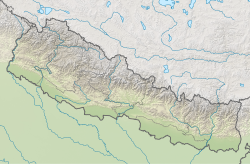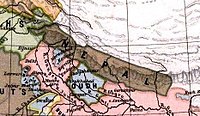
Back مملكة نيبال Arabic Königreich Nepal German Βασίλειο του Νεπάλ Greek Reĝlando Nepalo Esperanto Reino de Nepal Spanish Nepali Kuningriik Estonian پادشاهی نپال Persian Nepalin kuningaskunta Finnish Royaume du Népal French ממלכת נפאל HE
This article includes a list of general references, but it lacks sufficient corresponding inline citations. (August 2019) |
Kingdom of Nepal
| |
|---|---|
| 1768–2008 | |
| Motto: Janani Janmabhūmishcha Swargādapi Garīyasī (Sanskrit) Mother and Motherland are greater than heaven | |
| Anthem: 1962–2006: "Srīmān Gambhīr" (Nepali: श्रीमान गम्भीर) (English: "May Glory Crown You, Courageous Sovereign") 2007–2008: "Sayauṁ thum̐gā phūlakā" (Nepali" सयौँ थुँगा फूलका) (English: "Made of Hundreds of Flowers") | |
 Territory of the Kingdom of Nepal in 1808 | |
 Territory of the Kingdom of Nepal in 2008 | |
| Status |
|
| Capital and largest city | Kathmandu 27°42′N 85°19′E / 27.700°N 85.317°E |
| Common languages | Nepali (official) Newari (official, literature and administration language in the initial period)[1][2][3] [note 1] Other native language in Nepal |
| Religion | Hinduism (official) |
| Demonym(s) | Nepalese Nepali |
| Government | Unitary absolute monarchy (1768–1990; 2002; 2005–2006)
Unitary parliamentary constitutional monarchy
|
| Mahārājādhirāja | |
• 1768–1775 (first) | Prithvi Narayan Shah |
• 2001–2008 (last) | Gyanendra Shah |
| Prime Minister | |
• 1799–1804 (first) | Damodar Pande |
• 2006–2008 (last) | Girija Prasad Koirala |
| Legislature |
|
| Senate (1959–1960) National Assembly (1990–2002) | |
| House of Representatives (1959–1960; 1990–2002) | |
| History | |
• Unification under Prithivi Narayan Shah | 25 September 1768[5] |
| 1806–1837 and 1843–1845 | |
| 1799–1804 and 1837–1840 | |
| 1846–1951 | |
| 1960–1990 | |
| 1990–2008 | |
• Republic | 28 May 2008 |
| Currency |
|
| ISO 3166 code | NP |
| Today part of | Nepal India China Bangladesh |
| History of Nepal |
|---|
 |
|
|
The Kingdom of Nepal (Nepali: नेपाल अधिराज्य) was a Hindu kingdom in South Asia, formed in 1768 by the expansion of the Gorkha Kingdom, which lasted until 2008 when the kingdom became the Federal Democratic Republic of Nepal.[6] It was also known as the Gorkha Empire (Nepali: गोरखा अधिराज्य), or sometimes Asal Hindustan (Nepali: असल हिन्दुस्तान, lit. 'Real Land of the Hindus').[note 2] Founded by King Prithvi Narayan Shah, a Gorkha monarch who claimed to be of Khas Thakuri origin,[8][note 3] it existed for 240 years until the abolition of the Nepalese monarchy in 2008. During this period, Nepal was formally under the rule of the Shah dynasty, which exercised varying degrees of power during the kingdom's existence.
After the invasion of Tibet and plundering of Digarcha by Nepali forces under Prince Regent Bahadur Shah in 1792, the Dalai Lama and Chinese Ambans reported to the Chinese administration for military support. The Chinese and Tibetan forces under Fuk'anggan attacked Nepal but went for negotiations after failure at Nuwakot.[10] Mulkaji Damodar Pande, who was the most influential among the four Kajis, was appointed after the removal of Bahadur Shah.
Chief Kaji (Mulkaji) Kirtiman Singh Basnyat,[11] tried to protect king Girvan Yuddha Shah and keep former king, Rana Bahadur Shah away from Nepal. However, on 4 March 1804, the former king came back and took over as Mukhtiyar and Damodar Pande was then beheaded in Thankot.[12] The 1806 Bhandarkhal massacre instigated upon the death of Rana Bahadur Shah, set forth the rise of the authoritative Mukhtiyar Bhimsen Thapa,[13] who became the de facto ruler of Nepal from 1806 to 1837.[14] During the early nineteenth century, however, the expansion of the East India Company's rule in India led to the Anglo-Nepalese War (1814–1816), which resulted in Nepal's defeat.
Under the Treaty of Sugauli, the kingdom retained its internal independence, but in exchange for territorial concessions, marking the Mechi and Sharda rivers as the boundary of Nepalese territories.[15] The territory of the kingdom before the Sugauli treaty is sometimes nascently referred to as Greater Nepal. In the political scenario, the death of Mukhtiyar Mathbar Singh Thapa ended the Thapa hegemony and set the stage for the Kot massacre.[16] This resulted in the ascendancy of the Rana dynasty of Khas (Chhetri) and made the office of the Prime Minister of Nepal hereditary in their family for the next century, from 1843 to 1951. Beginning with Jung Bahadur, the first Rana ruler, the Rana dynasty reduced the Shah monarch to a figurehead role. The Rana rule was marked by tyranny, debauchery, economic exploitation and religious persecution.[17][18]
In July 1950, the newly independent Republic of India signed a friendship treaty in which both nations agreed to respect the other's sovereignty as well as continue to have an open border. In November of the same year, India played an important role in supporting King Tribhuvan, whom the Rana leader Mohan Shumsher Jang Bahadur Rana had attempted to depose and replace with his infant grandson who would later become King Gyanendra. With Indian support for a new government consisting largely of the Nepali Congress, King Tribhuvan ended the Rana regime in 1951.
Unsuccessful attempts were made to implement reforms and adopt a constitution during the 1960s and 1970s. An economic crisis at the end of the 1980s led to a popular movement that brought about parliamentary elections and the adoption of a constitutional monarchy in 1990. The 1990s saw the beginning of the Nepalese Civil War (1996–2006), a conflict between government forces and the insurgent forces of the Communist Party of Nepal (Maoist). The situation of the Nepalese monarchy was further destabilised by the 2001 Nepalese royal massacre.
As a result of the massacre, King Gyanendra returned to the throne. His imposition of direct rule in 2005 provoked a protest movement unifying the Maoist insurgency and pro-democracy activists. He was eventually forced to restore the House of Representatives, which in 2007 adopted an interim constitution greatly restricting the powers of the Nepalese monarchy. Following an election held the next year, the Nepalese Constituent Assembly formally abolished the kingdom in its first session on 28 May 2008, declaring the Federal Democratic Republic of Nepal in its place.
Until the abolition of the monarchy, Nepal was the world's only country to have Hinduism as its state religion; since becoming a republic, the country is now formally a secular state.[19][20]
- ^ Nepal Bhasa Sahityaya Itihas: History of Nepalbhasa Literature.Tuladhar, Prem Shanti (2000). Kathmandu: Nepal Bhasa Academy. ISBN 99933-56-00-X. Page 37: "The early new rulers cultivated Newari language. Kings Prithvi Narayan Shah, Rana Bahadur and Rajendra Bikram Shah composed poetry and wrote many plays in Newari".
- ^ Levy, Robert I. (1990) Mesocosm: Hinduism and the Organization of a Traditional Newar City in Nepal. Delhi: Motilal Banarsidass Publishers. ISBN 81-208-1038-4. Page 15:"Following the advent of the Shahs, the Gorkhali language became the court language, and Newari was replaced as the language of administration".
- ^ Malla, kamal. History of the Nepal. Kathmandu, Nepal: Rolwaling press. p. 155
- ^ Lienhard 1992, p. 3.
- ^ Subba, Sanghamitra (20 December 2019). "A future written in the stars". Nepali Times. Archived from the original on 31 January 2021. Retrieved 31 January 2021.
- ^ Kirkpatrick, Colonel (1811). An Account of the Kingdom of Nepaul. London: William Miller. pp. 382–386. Retrieved 17 October 2012.
- ^ Acharya, Baburam; Naraharinath, Yogi (2014). Badamaharaj Prithivi Narayan Shah ko Divya Upadesh (2014 Reprint ed.). Kathmandu: Shree Krishna Acharya. pp. 4, 5. ISBN 978-99933-912-1-0.
- ^ Karl J. Schmidt (20 May 2015). An Atlas and Survey of South Asian History. Routledge. pp. 138–. ISBN 978-1-317-47681-8. Archived from the original on 16 February 2017. Retrieved 5 February 2017.
- ^ Hamilton 1819, p. 26.
- ^ "Nepal and Tibetan conflict". Official website of Nepal Army. Archived from the original on 20 December 2016. Retrieved 29 April 2017.
- ^ Pradhan 2012, p. 12.
- ^ Nepal:The Struggle for Power Archived 5 July 2009 at the Wayback Machine (Sourced to U.S. Library of Congress)
- ^ Acharya 2012, pp. 71–72.
- ^ Whelpton 1991, p. 21.
- ^ "History of Nepal: A Sovereign Kingdom". Official website of Nepal Army. Archived from the original on 28 December 2017. Retrieved 29 April 2017.
- ^ Acharya 2012, pp. 11–12.
- ^ Dietrich, Angela (1996). "Buddhist Monks and Rana Rulers: A History of Persecution". Buddhist Himalaya: A Journal of Nagarjuna Institute of Exact Methods. Archived from the original on 1 October 2013. Retrieved 17 September 2013.
- ^ Lal, C. K. (16 February 2001). "The Rana resonance". Nepali Times. Archived from the original on 28 September 2013. Retrieved 17 September 2013.
- ^ "Why Monarchy is necessary in Nepal?". 28 October 2009. Archived from the original on 12 April 2020. Retrieved 3 November 2009.
- ^ George Conger (18 January 2008). "Nepal moves to become a secular republic". Religious Intelligence. Archived from the original on 30 January 2009.
Cite error: There are <ref group=note> tags on this page, but the references will not show without a {{reflist|group=note}} template (see the help page).
© MMXXIII Rich X Search. We shall prevail. All rights reserved. Rich X Search


